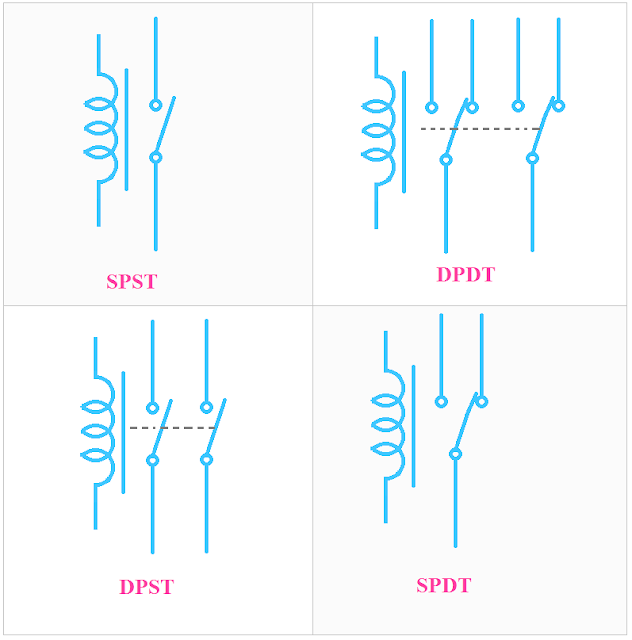[Explained] Main Differences Between Relay and Contactor
Relay and Contactor Difference
The main difference between Relay and Contactor is, Relay is used in low-power, low-current carrying circuits for switching and controlling but Contactor is used in high-power, high-current carrying circuits for switching purposes. The other important differences between Contactor and Relay are given below.
Basically, Contactor and Relay both are electrically operated switches. To automatically control the electrical circuit we use Contactor and Relay. Contactor and Relay both work in the same principle. Both of them have electromagnets inside them. The simple working principle of Contactor and Relay is that when the electromagnet is energized by an external power supply, they change its contact mechanisms, such as NO(Normally Open) to NC(Normally Closed) or NC to NO.
Here you can see the symbolic difference between the relay and Contactor.
Relay VS Contactor
(1) First of all, the actual difference between the Contactor and Relay is, Relay is a low-power device whereas Contactor is High Power Device. Contactors are generally designed to handle higher power levels, typically ranging from a few kilowatts to several megawatts. On the other hand, Relays are designed for lower power applications, typically ranging from a few milliwatts to a few kilowatts.
(2) For up to 10 to 15A circuits Relays are used, whereas for more than 15A to 12500A circuits Contactors are used.
(3) Relays are smaller in size than Contactor whereas the Contactors are bigger in size than Relays. Contactors are heavier than the Relays.
(4) Basically, Contactors are designed to operate at Normally Open(NO), on the other hand, Relays are designed to operate at Normally Open(NO) as well as Normally Closed(NC). But nowadays, some Contaauxiliarys auxiliary NC contacts. It is an important difference between Contactor and Relay.
(5) The main use of a Contactor is switching, but Relays are used for switching purposes as well as controlling purposes. But the modern Contactors also have auxiliary NC, NO contacts for using controlling purposes. I mean to say modern Contactors are also used for switching as well as controlling.
(6) Relays are comparatively low-cost devices than Contactors whereas Contactors are high-cost devices than Relays.
(7) A Relay cannot be used in a Power circuit for higher voltage, it is only used in a control circuit but Contactors are designed to use in a power circuit for higher voltage.
(8) Contractors are mainly designed for Three Phase applications whereas Relays are mainly designed for single-phase applications.
(9) Generally, Contactors are rated for up to 1000V but Relays are rated for up to 250V.
(10) As Contractors are designed for high current applications so they have some safety features such as spring-loaded contacts. Generally, spring-loaded contacts are used to prevent the internal short circuit of the Contactor when it carries a high current.
Contactor has another safety feature which is ARC suppression. As they carry a high current, there is a chance of producing ARC.
Relays do not have any safety features like spring contacts and an ARC suppression system. So it is a very important difference between Relay and Contactor.
(11) Generally, Contactors come with embedded Thermal Over Load relays which give Overload and Short Circuit protection. The relay has not overload protection facility.
(12) In modern days, many smart electrical, as well as electronic devices, use Relays, Contactor mainly used for ON/OFF the Motors, and other high-power devices such as large lighting systems, etc.
(13) Switching time of Relays is much faster than Contactors which is why Relays are also used as sensing Devices. Relays are suitable for applications where rapid switching is required, such as in electronic circuits, automation systems, or small-scale control applications whereas Contactors are commonly used in applications where the switching speed is not critical, such as in motor control, industrial machinery, or power distribution systems.
(14) Contactors consume more power as they have large electromagnets than Relays, on the other hand, Relay consumes low power as they have small electromagnets.
(15) Another important difference between the Contactor and Relay is, as the switching speed of the Relays very much faster than Contactors so they can be operated with electronic signals but Contactors cannot be used with electronic signals.
What should I Use Relay or Contactor?
As I already told you, For high-power applications Contactor is best. So for high-power applications, you should use Contactor. If you need a very fast switching speed then you must use Relay. For low-power applications always, use Relay because it can save your money. It is not economical to use Contactor for low-power applications.
Read Also:
- Difference between Analogue, Digital, and Power Electronics
- The Main Difference between Diode and Transistor
- The Main Difference between Relay and Solenoid
- The Main Difference between Relay and Circuit Breaker
- Rectifier VS Amplifier | The Main Difference
Thank you for visiting the website. keep visiting for more updates.


